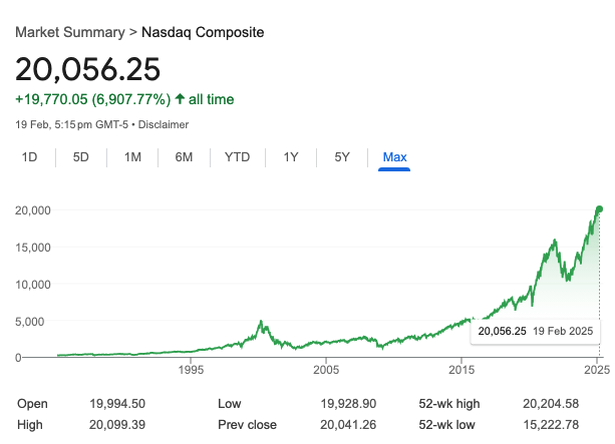The Nasdaq Composite is one of the most recognised names in the investment world, often making headlines alongside the Dow Jones Industrial Average and S&P 500. But what exactly is the Nasdaq Composite, and how does it work for retail investors like us here in Aotearoa?
Generally, the Nasdaq is used as short-hand to see what the technology sector is doing. We monitor the DJIA (See January newsletter), the S&P 500 (See February Newsletter) and the Nasdaq each day to get a feel for what markets are doing.
Investors may remember the 'tech-wreck' around 2000 where a lot of the companies were made of 'hot air'. The companies in the index are far more solid these days and a good indicator of innovation.
This blog article is giving you more information on the index and how it works.
What is the Nasdaq Composite?
It's a stock market index that encompasses nearly all the stocks listed on the Nasdaq Stock Exchange. Unlike some other indices that focus on specific sectors or company sizes, the Nasdaq Composite casts a wide net, giving us a broad snapshot of the overall performance of Nasdaq-listed companies.
What's Inside?
The Nasdaq Composite isn't limited to just big-name tech giants, although it's heavily weighted towards the information technology sector. You'll find a diverse range of companies represented, including American depositary receipts (ADRs), common stock, limited partnership interests, real estate investment trusts (REITs), and shares of beneficial interest (SBIs).
There are some investment types that you won't find in the index, like closed-end funds, convertible bonds, preferred stocks, and various derivatives. Essentially, the Nasdaq Composite focuses on the core equity listings of companies on the Nasdaq exchange.
How Does It Work?
The Nasdaq Composite is what's known as a capitalisation-weighted index.
This means a company's influence on the index's movement is determined by its market capitalisation (share price multiplied by the number of outstanding shares) (Like the DJIA). Larger companies have a bigger impact on the index's overall value.
Can You Invest Directly?
No, you can't buy shares in an index directly. However, you can invest in index funds, which aim to mirror the index's performance.
These funds are like baskets holding all (or a representative sample) of the stocks included in the index. When you invest in an index fund, you're essentially investing in a slice of the entire index.
Moneyworks uses a 'defined index' fund to provide our clients with access to the Nasdaq 100 without any Australian shares or financial shares in it in our clients portfolios.
A Bit of History
The Nasdaq Composite has seen its fair share of ups and downs over the years.
It launched in 1971 with a starting value of 100 and has experienced periods of explosive growth, like during the dot-com boom of the late 1990s, as well as significant corrections. {See the graph with this article]
Why Does It Matter?
The Nasdaq Composite serves as a barometer for the health of the US technology sector and the broader market. Its movements can provide insights into investor sentiment, economic trends, and the performance of specific industries.
Keeping an eye on the Nasdaq Composite can help you understand market dynamics and make more informed investment decisions.
Remember:
● Investing in the stock market involves risk.
● Past performance isn't a guarantee of future returns.
● It's essential to research thoroughly and consider your investment goals and risk tolerance before making any investment decisions.
● Seeking advice from a qualified financial adviser is always recommended.
Need help navigating the complexities of the stock market? Get in touch with the team at Moneyworks for personalised financial advice tailored to your specific needs. We're here to help you achieve your financial goals.


